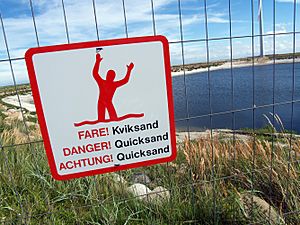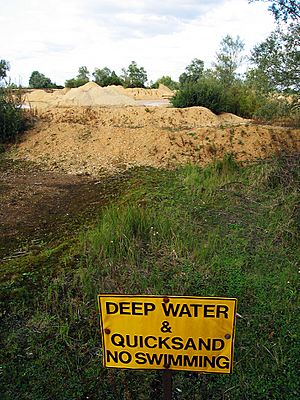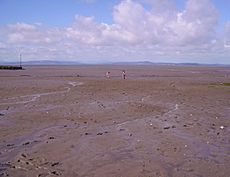Quicksand facts for kids

Quicksand is a special mix of water and sand or fine dirt called silt. It looks solid, like regular ground, but it can suddenly turn into a liquid when you put pressure on it. This unique behavior is called thixotropy. If animals or people step on it, they start to sink.
But here's a surprising fact: a person won't completely drown in quicksand. This is because the quicksand is actually thicker, or more dense, than a human body. So, you float in it, even if you're sinking. The real problem is how hard it is to get out! You can escape quicksand by moving your legs slowly to make the sand less sticky, and then gently rolling onto your back to float.
Quicksand forms when underground water moves through an area with just the right mix of fine sands and other materials like clay. The water moves up and down slowly, like a gentle current, within the sand. This movement makes the sand particles slippery, so they can't support much weight. They act more like a liquid when something heavy presses on them. Often, the water doesn't reach the very top, so the surface of the quicksand can look solid, covered with leaves or small bits of dirt. This makes it very tricky to spot quicksand from the surrounding ground.
What is Quicksand?
Quicksand is a type of non-Newtonian fluid. This means it doesn't act like normal liquids, such as water. When quicksand is left alone, it often seems like a solid (we can call this its "gel" form). But if you put even a little bit of weight or stress on it, it quickly turns into a liquid (its "sol" form). This change causes its viscosity (how thick or sticky it is) to suddenly drop. When you step on it, you start to sink into this liquid-like sand.
As you sink, the sand around you can become very dense and compact. It then grips you tightly, and the quicksand seems to become much thicker again, turning back into its "gel" form. To move your body or a foot in quicksand, you need to push hard enough to make the sand liquid again by mixing in more water. The force needed to pull a foot out of quicksand at just one centimeter per second is huge. It's like trying to lift a medium-sized car!
Scientists used to think quicksand's behavior was only due to sand being completely soaked in water. They thought underground water pressure pushed the sand particles apart, reducing the friction between them. However, in 2005, new research showed that salt also plays an important role. Salt changes how stable the quicksand mixture is. It makes the thick, sticky areas of sand even stronger, which is why quicksand can trap things so well. Another interesting discovery was that a person cannot be pulled completely under by saltwater quicksand.
Where Can You Find Quicksand?
You can find quicksand in many places, both inland and near the coast. Inland, it might be on riverbanks, close to lakes, or in marshy areas. Along the coast, it can appear on beaches or in tidal flats.
One famous area known for its quicksands is Morecambe Bay in Yorkshire, England. This bay is very wide and shallow. If someone gets stuck in the quicksand there, they are also in danger from the incoming tide, which can rush in very quickly.
Images for kids
-
Quicksand on the River Thames.
-
Hikers finding quicksand on the banks of the Paria River, Utah.
-
A quicksand warning sign near Lower King Bridge, Western Australia.
See also
 In Spanish: Arenas movedizas para niños
In Spanish: Arenas movedizas para niños






